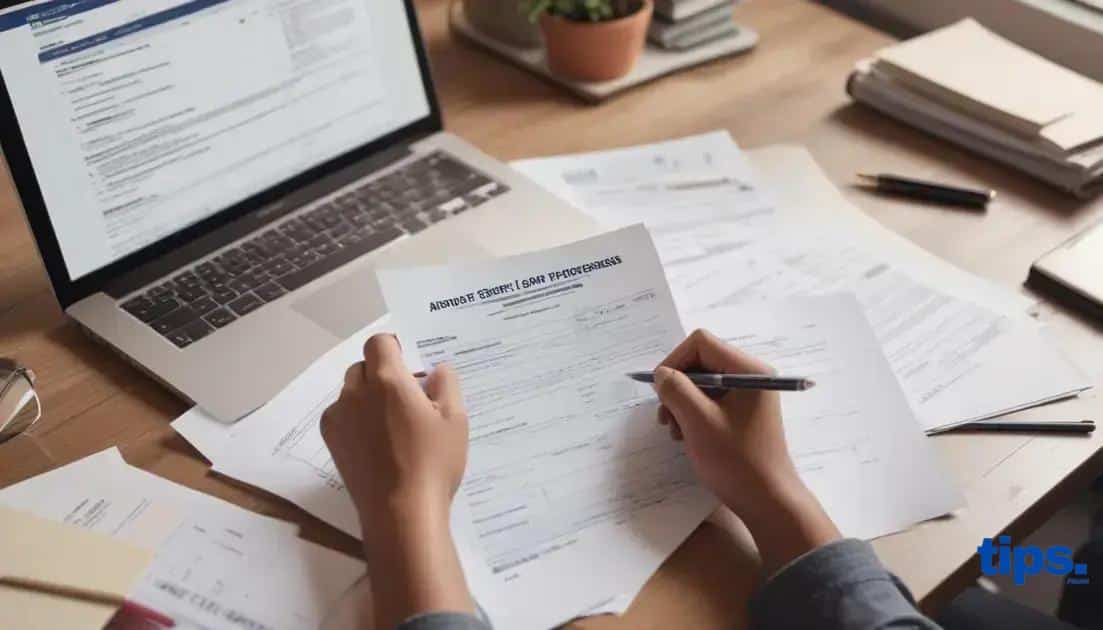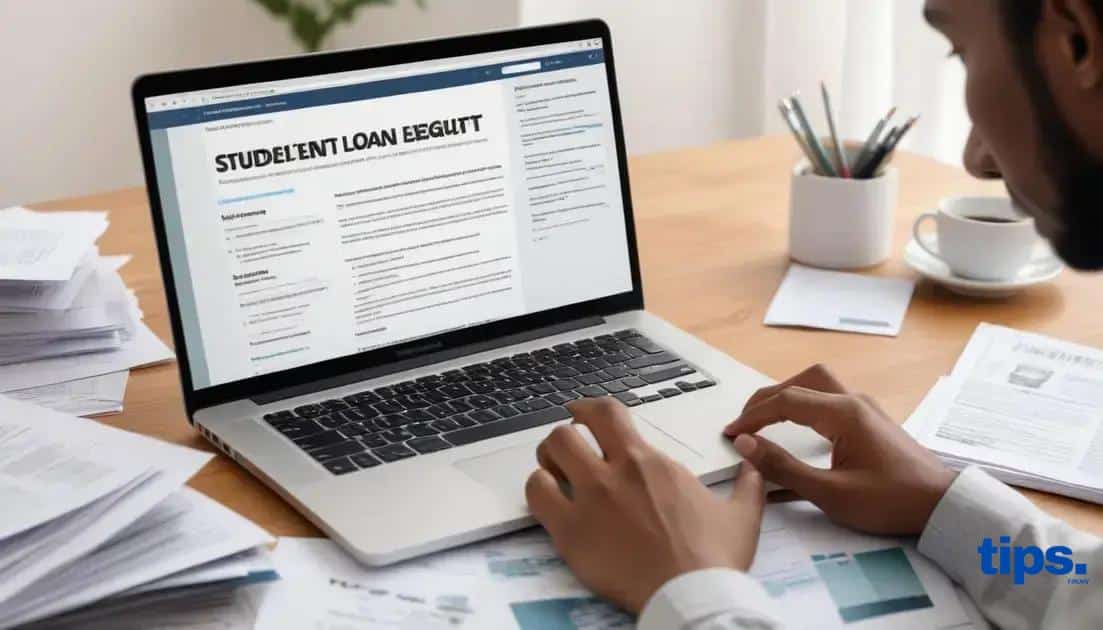Student loan forgiveness programs: what you need to know

Anúncios
Student loan forgiveness programs can significantly reduce your debt, but eligibility varies by program, and forgiven amounts may be considered taxable income.
Student loan forgiveness programs are designed to provide relief for borrowers struggling with debt. Have you ever wondered how these programs work or if you qualify? This guide will walk you through the essentials.
Anúncios
Understanding student loan forgiveness programs
Understanding student loan forgiveness programs is crucial for anyone looking to relieve their financial burden. These programs aim to help borrowers clear their debt under certain conditions.
Some programs require a commitment to public service roles, while others may depend on specific repayment plans or employment in qualifying fields.
Types of Student Loan Forgiveness Programs
There are several options available, and each has unique eligibility criteria:
Anúncios
- Public Service Loan Forgiveness (PSLF): Designed for those working in government or non-profit sectors.
- Teacher Loan Forgiveness: Aimed at teachers working in low-income schools.
- Income-Driven Repayment Forgiveness: Provides forgiveness after a set number of qualifying payments.
Make sure to research the specific requirements for each program, as they can vary significantly.
For more detailed information, visit the U.S. Department of Education website.
Types of forgiveness options available
There are several types of forgiveness options available for student loans, each catering to different professions and circumstances. Understanding these options can help you take advantage of the benefits they offer.
One key program is the Public Service Loan Forgiveness (PSLF). This program forgives your remaining loan balance after you have made 120 qualifying monthly payments while working full-time for a qualifying employer.
Types of Forgiveness Options
Here are some notable forgiveness programs:
- Income-Driven Repayment (IDR) Forgiveness: After 20 or 25 years of qualifying payments, remaining loan balances may be forgiven.
- Teacher Loan Forgiveness: This option rewards teachers who work in low-income schools with forgiveness up to $17,500.
- Veterans Affairs (VA) Loan Forgiveness: Certain programs offer forgiveness for veterans in public service.
It’s essential to research each program’s specific eligibility criteria. For further details, visit the U.S. Department of Education for comprehensive guidance.
Eligibility requirements for forgiveness
Eligibility requirements for student loan forgiveness vary by program, but most share common criteria. Understanding these requirements is vital for deciding if you qualify for assistance.
For the Public Service Loan Forgiveness (PSLF) program, you must be employed by a qualifying employer and make 120 qualifying monthly payments under a qualified repayment plan.
Common Eligibility Criteria
Many forgiveness programs have specific eligibility requirements, including:
- Employment Status: You often must work full-time in a qualified field, like public service or education.
- Loan Type: Not all loans qualify for forgiveness. Federal Direct Loans generally take precedence.
- Repayment Plan: Some programs require you to be on an income-driven repayment plan to qualify for forgiveness.
To find the complete list of requirements for each program, visit the U.S. Department of Education website.
How to apply for student loan forgiveness

Applying for student loan forgiveness requires careful preparation and understanding of the specific program you are targeting. Each program may have its unique application process.
Firstly, gather all necessary documentation to support your application. This may include proof of employment, income documents, and your loan details.
Steps to Apply for Forgiveness
Here are the general steps you should follow when applying:
- Identify the right program: Research different forgiveness options to find one that fits your situation.
- Complete the application: Fill out the required forms accurately, ensuring that all information is up to date.
- Submit documentation: Attach supporting documents as requested and keep copies for your records.
After submitting your application, it is important to follow up to ensure it is being processed. For more detailed instructions, visit the U.S. Department of Education website.
Common misconceptions about forgiveness programs
There are many common misconceptions about student loan forgiveness programs that can lead to confusion and misinformation. Understanding the truth behind these myths is crucial for anyone considering these options.
One significant misconception is that all federal student loans qualify for forgiveness. In reality, not all loans are eligible, and many programs have specific requirements.
Misconceptions Defined
Here are some prevalent myths:
- Myth 1: You can receive forgiveness just by applying. In truth, you must meet specific eligibility criteria and follow through with requirements.
- Myth 2: Loan forgiveness will be automatic after a set time. Typically, you must actively manage your application and documentation during the forgiveness process.
- Myth 3: Forgiveness programs are only for public service workers. In fact, there are options available for teachers, nurses, and others based on various conditions.
For accurate information on student loan forgiveness, visit the U.S. Department of Education website.
| Topic | Action | Details |
|---|---|---|
| Program Purpose | Reduce student debt | Forgiveness for eligible borrowers |
| Main Programs | PSLF, IDR, Teacher Forgiveness | Each has specific criteria |
| Eligibility | Meet job, loan, and payment rules | Often requires full-time employment |
| How to Apply | Complete forms and submit proof | Include employment and income docs |
| Common Myths | Clarify misconceptions | Not all loans or jobs qualify |
| Credit Score Impact | Monitor credit changes | Forgiveness may lower debt ratio |
| Tax Implications | Check IRS rules | Forgiven debt may be taxable income |
| Helpful Resources | Use official tools | Visit Federal Student Aid, CFPB |
Impact of forgiveness on your credit score
The impact of forgiveness on your credit score can be significant, and understanding this effect is important. When loans are forgiven, it may alter how creditors view your creditworthiness.
Generally, having student loan debt can affect your credit score, but once the loans are forgiven, the outcome can vary. Your score may improve or remain stable, depending on several factors.
How Forgiveness Affects Your Score
Here are a few key points to consider:
- Debt to Income Ratio: Forgiveness reduces your total debt, which can positively impact your debt-to-income ratio.
- Payment History: If you have been making timely payments, this positive history can benefit your score even when loans are forgiven.
- Credit Mix: Having a variety of credit accounts is good. Losing an installment loan like student debt may lessen this variety.
To understand how forgiveness affects your specific situation, it’s advisable to check your credit report and speak with a financial advisor. For more detailed information about credit scores, visit the myFICO website.
Tax implications of forgiven loans
Understanding the tax implications of forgiven loans is essential for borrowers pursuing student loan forgiveness. While forgiveness can ease your financial burden, it may also have tax consequences.
In many cases, forgiven student loans are considered taxable income. This means you may owe taxes on the amount that gets forgiven, impacting your financial situation.
Key Tax Considerations
Here are some important points to remember:
- Taxable Income: According to the IRS, forgiven loans may count as taxable income in the year they are forgiven.
- Exemptions: Some forgiveness programs, like Public Service Loan Forgiveness, may be exempt from taxation under certain conditions.
- Consult a Tax Professional: Always a good idea to talk with a tax advisor to understand how forgiveness will affect your specific tax situation.
For more detailed information on how loan forgiveness affects taxes, visit the IRS website.
Resources for further assistance

Finding the right resources for further assistance with student loan forgiveness can help you navigate the complex landscape of loans and eligibility. There are various organizations and websites that provide valuable information and support.
These resources can guide you through the application process and help clarify any confusion regarding forgiveness programs.
Available Resources
Here are some trusted resources to consider:
- Federal Student Aid: The Federal Student Aid website offers a wealth of information on all aspects of student loans, including forgiveness options.
- Consumer Financial Protection Bureau (CFPB): The CFPB website has tools and resources that can help you understand your rights and options.
- Local Nonprofits: Many local nonprofits provide free counseling services related to student loans and financial literacy.
Utilizing these resources can empower you to make informed decisions about your student loan situation.
Understanding Your Options for Student Loan Forgiveness
Student loan forgiveness programs can provide significant relief for borrowers struggling with debt. However, navigating these options requires knowledge and careful planning.
By understanding the various types of forgiveness programs, eligibility requirements, and tax implications, you can take the necessary steps towards financial freedom.
Additionally, utilizing available resources can help you make informed decisions and stay on track throughout the process. Remember, you are not alone in this journey, and support is available.
With the right information and perseverance, you can work towards a more manageable financial future.





